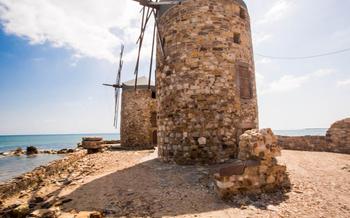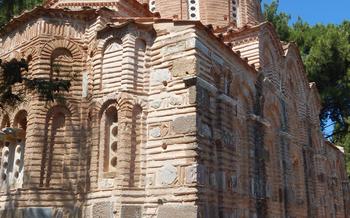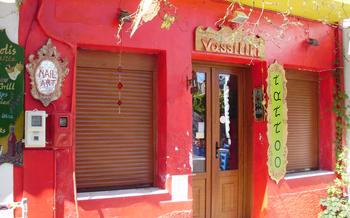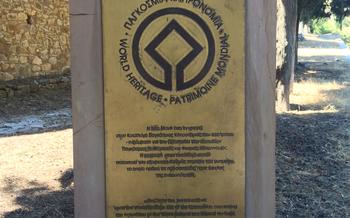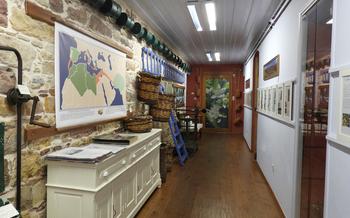
Nea Moni Monastery
- Nea Moni Monastery: A Historical and Architectural Gem
- Location and Accessibility
- History of the Monastery
- Architectural Features
- Visiting the Monastery
- Highlights of the Interior
- Exploring the Monastery Grounds
- Byzantine Art and Architecture
- Religious Importance
- Cultural Heritage and Preservation
- Local Traditions and Customs
- Off-the-Beaten-Track Destination
- Combining History and Nature
- Photography and Social Media
- Insider Tip: Exploring the Hidden Chapel
Nea Moni Monastery: A Historical and Architectural Gem
Nestled amidst the verdant hills of Chios, the Nea Moni Monastery stands as a testament to the rich history, architectural brilliance, and religious significance that have shaped the island's cultural heritage. Founded in the 11th century by Emperor Constantine IX Monomachos, this Byzantine masterpiece has earned its place as a UNESCO World Heritage Site, attracting visitors from around the globe who seek to immerse themselves in its sacred atmosphere and marvel at its architectural wonders.
The Nea Moni Monastery is not just a historical relic; it is a living testament to the enduring power of faith and the resilience of the Greek Orthodox tradition. With its stunning mosaics, intricate frescoes, and awe-inspiring Byzantine architecture, this monastery continues to inspire and captivate those who step within its hallowed walls.
Location and Accessibility
The Nea Moni Monastery is situated on the picturesque island of Chios, a hidden gem in the Aegean Sea. Nestled within the tranquil village of Nea Moni, the monastery lies just 15 kilometers southwest of Chios Town, the island's capital. Its secluded location amidst verdant hills offers a respite from the bustling city, inviting visitors to immerse themselves in its serene atmosphere.
Reaching the Nea Moni Monastery is a breeze. Whether you prefer the convenience of a guided tour or the freedom of self-exploration, several transportation options are available. Guided tours departing from Chios Town provide a hassle-free way to visit the monastery, allowing you to sit back and enjoy the scenic journey while learning about its history and significance.
For those seeking a more independent experience, renting a car or hiring a taxi is an excellent choice. The well-maintained roads of Chios make it easy to navigate, and the drive to the monastery offers breathtaking views of the island's lush landscapes. Once you arrive in Nea Moni village, follow the signs to the monastery, which is just a short walk from the village center.
History of the Monastery
Nea Moni Monastery, a testament to the architectural and cultural heritage of Greece, owes its existence to the vision of Emperor Constantine IX Monomachos, who played a pivotal role in its foundation during the 11th century. The emperor, known for his patronage of the arts and his deep religious devotion, sought to create a sanctuary that would serve as a beacon of spirituality and learning within the Byzantine Empire.
Under the guidance of skilled architects and artisans, the monastery's construction began in the 11th century, drawing upon the rich traditions of Byzantine architecture. The builders employed intricate techniques and incorporated elements that reflected the empire's distinctive style, resulting in a harmonious blend of functionality and artistic expression.
The monastery's completion marked a significant milestone in the religious and cultural landscape of the Byzantine Empire. It quickly became a renowned center of monastic life, attracting monks and scholars from across the region who sought to immerse themselves in the spiritual teachings and intellectual pursuits fostered within its walls.
Throughout the centuries, Nea Moni Monastery remained a vibrant hub of religious activity, contributing to the preservation and dissemination of Byzantine culture and traditions. Its enduring legacy as a sacred site and a repository of Byzantine art and architecture continues to captivate visitors from around the world, perpetuating its significance as a cherished historical and cultural treasure.
Architectural Features
The Nea Moni Monastery is renowned for its remarkable architectural features, blending Byzantine and medieval styles. The centerpiece of the complex is the Church of the Dormition of the Theotokos, a stunning edifice that showcases the monastery's architectural prowess. The church's interior is adorned with exquisite mosaic decorations, depicting various biblical scenes and figures with intricate detail and vibrant colors. The walls and ceilings are further embellished with frescoes and paintings, narrating stories from the Bible and the lives of saints. The monastery also boasts a bell tower, an impressive structure that rises above the complex, offering panoramic views of the surrounding landscape. Other notable architectural features include the refectory, the library, and the living quarters, which provide a glimpse into the daily life of the monks and nuns.
Visiting the Monastery
Opening Hours and Admission Fees
The Nea Moni Monastery welcomes visitors from Tuesday to Sunday, with varying opening hours depending on the season. It is closed on Mondays. Admission fees are minimal and contribute to the preservation and upkeep of the monastery.
Guided Tours and Self-Exploration
Guided tours in English and Greek are available upon request and provide in-depth insights into the history, architecture, and religious significance of the monastery. Visitors can also opt for self-exploration, wandering through the grounds and admiring the beauty of the monastery at their own pace.
Dress Code and Monastery Etiquette
As a sacred religious site, the Nea Moni Monastery has a dress code that requires visitors to dress respectfully. Shoulders and knees should be covered, and revealing clothing is not permitted. Visitors are also expected to maintain a respectful demeanor, being mindful of the monks and nuns who still reside in the monastery.
Photography and Filming Regulations
Photography and filming are generally permitted within the monastery, but certain areas may be restricted. Visitors are requested to be respectful and not disturb the monks or other visitors while taking photographs. Commercial photography or filming requires prior permission from the monastery authorities.
Highlights of the Interior
Step inside the Nea Moni Monastery, and prepare to be awestruck by the stunning mosaics that adorn the walls and ceilings. These intricate works of art depict biblical scenes with remarkable detail and artistry. Gaze upon the mosaic of the Virgin Mary enthroned with the infant Jesus, surrounded by angels and saints. Admire the scenes from the life of Christ, from his birth to his crucifixion and resurrection. Each mosaic is a masterpiece in its own right, showcasing the skill and devotion of the Byzantine artisans who created them.
In addition to the mosaics, the monastery is home to a collection of exquisite frescoes and paintings. These works of art depict a variety of religious subjects, including the life of the Virgin Mary, the saints, and the miracles of Christ. The frescoes are particularly impressive for their vibrant colors and expressive figures. Take your time to study each one, and let the stories they tell transport you back in time.
The carved marble iconostasis, or screen, that separates the nave from the sanctuary is another highlight of the monastery's interior. This intricate work of art features a series of icons depicting Christ, the Virgin Mary, and the saints. The iconostasis is a masterpiece of Byzantine craftsmanship, and it adds a touch of grandeur to the monastery's already impressive interior.
Finally, don't miss the opportunity to view the relics and sacred objects that are housed in the monastery. These include the skull of Saint Isidore, a fragment of the True Cross, and an icon of the Virgin Mary that is said to be miraculous. These relics are of great importance to Orthodox Christians, and they add to the spiritual significance of the Nea Moni Monastery.
Exploring the Monastery Grounds
As you step outside the main church, the monastery's grounds unfold before you, inviting you to explore its tranquil corners. A charming courtyard greets you with its lush gardens and soothing fountains, providing a peaceful retreat from the outside world. Take a moment to stroll amidst the greenery, letting the gentle sound of water lull you into a state of serenity.
Within the monastery complex, a small museum awaits, housing a collection of religious artifacts and treasures. Here, you can delve deeper into the history and significance of Nea Moni, gaining insights into the lives of the monks who once called this place their home. Ancient manuscripts, intricate religious objects, and fascinating relics tell the story of the monastery's rich past.
One of the highlights of the grounds is the panoramic view that unfolds before you. Ascend to the upper levels of the monastery, and you'll be rewarded with breathtaking vistas of the surrounding landscape. The deep blue of the Aegean Sea stretches out towards the horizon, while the lush greenery of Chios Island paints a vibrant tapestry below. Let your gaze wander across the rolling hills, olive groves, and distant villages, feeling a sense of tranquility and awe.
Throughout your exploration of the monastery grounds, you'll be enveloped in a peaceful and serene atmosphere. The gentle chanting of the monks, the rustling of leaves in the breeze, and the distant sound of church bells create a symphony of tranquility. Allow yourself to be transported back in time, immersing yourself in the spiritual essence that permeates every corner of this sacred place.
Byzantine Art and Architecture
Nea Moni Monastery stands as a remarkable testament to the flourishing of Byzantine art and architecture during the 11th century. Its intricate mosaics, frescoes, and carved marble iconostasis exemplify the artistic and cultural achievements of the Byzantine Empire. The monastery's design incorporates elements of both Eastern and Western traditions, reflecting the empire's position as a crossroads of civilizations.
The mosaics, which adorn the interior walls and domes of the church, depict biblical scenes and figures with exceptional detail and vibrancy. These exquisite works of art demonstrate the mastery of Byzantine artisans in capturing religious narratives through visual storytelling. The frescoes, which complement the mosaics, further enhance the interior with their rich colors and expressive depictions of saints and biblical events.
The carved marble iconostasis, which separates the sanctuary from the nave, is another highlight of the monastery's artistic heritage. Intricately crafted with biblical scenes and figures, the iconostasis stands as a testament to the skill and artistry of Byzantine sculptors.
Nea Moni Monastery's architectural features, such as the domed roof, arched windows, and elaborate ornamentation, showcase the distinctive characteristics of Byzantine architecture. The monastery's design reflects the Byzantine emphasis on light and space, creating an awe-inspiring and ethereal atmosphere within the church.
In comparing Nea Moni Monastery with other Byzantine monasteries, it stands out for its exceptional preservation and the richness of its artistic adornments. While many Byzantine monasteries have undergone modifications or been damaged over time, Nea Moni has retained its original features and remains a well-preserved example of 11th-century Byzantine architecture.
Religious Importance
Nea Moni Monastery holds immense religious significance for Orthodox Christians worldwide. It is a revered pilgrimage site, attracting thousands of faithful visitors each year. The monastery's most sacred relic is the miraculous icon of the Virgin Mary, known as the "Megali Panagia" (Great Mother of God). According to legend, the icon was discovered by a monk in a nearby cave and is believed to possess healing powers. Pilgrims come from far and wide to venerate the icon, seeking blessings and divine intervention.
Throughout the year, Nea Moni Monastery hosts various feasts and celebrations honoring the Virgin Mary and other religious figures. The most significant event is the annual Panagia's Day celebration, held on August 15th. During this festival, the icon is carried in a grand procession through the monastery grounds, accompanied by prayers, hymns, and traditional dances. The monastery's serene atmosphere and spiritual energy make it a sanctuary for reflection, prayer, and devotion, attracting those seeking a deeper connection with their faith.
Cultural Heritage and Preservation
Nea Moni Monastery's exceptional cultural and historical value has been recognized by UNESCO, which inscribed it as a World Heritage Site in 1990. This prestigious designation highlights the monastery's outstanding universal value and the need for its preservation and protection.
UNESCO's recognition has played a crucial role in raising awareness of the monastery's importance and the need to safeguard its unique features. It has also provided a framework for international cooperation and support for conservation and restoration projects.
The Greek government, in collaboration with UNESCO and other international organizations, has undertaken several initiatives to protect and preserve Nea Moni Monastery. These efforts include structural reinforcement, restoration of mosaics and frescoes, and the establishment of a museum within the monastery complex.
The monks and nuns residing at Nea Moni also play a vital role in preserving the monastery's cultural heritage. They are the custodians of its traditions and history, ensuring that the monastery remains a living testament to Byzantine art and architecture.
The preservation of Nea Moni Monastery is not only essential for protecting its physical structures but also for safeguarding the intangible cultural heritage it represents. The monastery's rich history, religious significance, and artistic treasures contribute to the cultural identity of Greece and the Orthodox Christian world.
By preserving Nea Moni Monastery, we are preserving a tangible link to our past and ensuring that future generations can continue to appreciate its beauty and significance.
Local Traditions and Customs
Nea Moni Monastery is deeply intertwined with the local community of Chios. The monks and nuns have played an important role in preserving and promoting the island's cultural heritage. They actively participate in local events and festivals, sharing their traditions and customs with visitors. Traditional festivals and customs, such as the celebration of the Virgin Mary's feast day, are observed at the monastery, attracting both locals and pilgrims. Visitors have the chance to interact with the monks and nuns, gaining insights into their daily lives and the spiritual significance of the monastery. These interactions offer a unique glimpse into the local culture and provide a deeper understanding of the religious and social fabric of Chios.
Off-the-Beaten-Track Destination
Nestled amidst the tranquil landscapes of Chios, Nea Moni Monastery offers a unique and authentic experience, far from the bustling crowds of popular tourist destinations. Its secluded location provides a sanctuary of peace and serenity, allowing travelers to immerse themselves in the monastery's rich history and spiritual ambiance. As you wander through the monastery grounds, surrounded by lush gardens and ancient olive trees, you'll feel transported to a different era, where time seems to stand still.
The monastery's isolation from major tourist routes makes it an ideal destination for those seeking a genuine and intimate encounter with Byzantine art and architecture. Here, you'll have the opportunity to explore the monastery's hidden corners and admire its intricate mosaics and frescoes without the distractions of large tour groups. Nea Moni Monastery invites you to connect with the local community and discover the hidden gems of Chios, creating lasting memories that will stay with you long after your visit.
Combining History and Nature
Nea Moni Monastery's allure extends beyond its historical and architectural significance, as it is nestled in a breathtaking natural setting. The surrounding area offers a plethora of opportunities for exploration and adventure. History buffs can embark on a journey to discover nearby historical sites, such as the medieval fortress of Chios Town or the ancient city of Volissos. Nature enthusiasts, on the other hand, can revel in the scenic hiking trails that wind through the picturesque landscapes of Chios. These trails offer panoramic views of the island's verdant hills, sparkling coastline, and the deep blue Aegean Sea. Visitors can immerse themselves in the tranquility of nature while appreciating the rich history and cultural heritage of the region. Whether you seek historical exploration or outdoor adventures, combining a visit to Nea Moni Monastery with these natural wonders promises an unforgettable experience.
Photography and Social Media
The Nea Moni Monastery is a feast for the eyes, and photography enthusiasts will find endless opportunities to capture its beauty. The stunning mosaics, intricate frescoes, and awe-inspiring architecture provide a picturesque backdrop for Instagram-worthy shots. Whether you're a professional photographer or simply enjoy taking snapshots to share with friends and family, the monastery offers a wealth of photogenic subjects.
Don't miss the chance to capture the intricate details of the mosaics, which depict biblical scenes with vibrant colors and expressive figures. The frescoes and paintings that adorn the walls and ceilings are equally impressive, showcasing the artistic mastery of the Byzantine era. The bell tower, with its imposing presence, offers a unique perspective of the monastery and the surrounding landscape.
As you explore the monastery grounds, keep an eye out for hidden corners and unique vantage points. The serene courtyard, with its lush gardens and trickling fountains, provides a tranquil setting for contemplative photography. The panoramic views from the monastery's elevated position offer breathtaking shots of the surrounding countryside, with the deep blue Aegean Sea stretching out to the horizon.
Remember to be respectful of the monastery's sacred nature and follow any photography regulations that may be in place. Share your stunning captures on social media, using relevant hashtags, to inspire others to discover this hidden gem of Chios. Your photos will not only showcase the beauty of the Nea Moni Monastery but also contribute to promoting the rich cultural heritage of Greece.
Insider Tip: Exploring the Hidden Chapel
Beyond the main attractions of the Nea Moni Monastery, there lies a hidden gem waiting to be discovered. Tucked away within the monastery complex is a secret chapel, rarely visited by tourists but offering a unique and serene experience. The chapel is adorned with exquisite frescoes, each telling a biblical tale with intricate detail and vibrant colors. The atmosphere within the chapel is one of tranquility and devotion, inviting visitors to immerse themselves in the spiritual essence of the monastery. For those seeking a deeper connection with the history and spirituality of Nea Moni, this hidden chapel is a treasure not to be missed.

